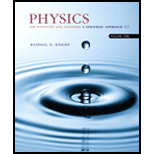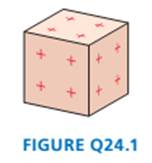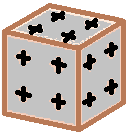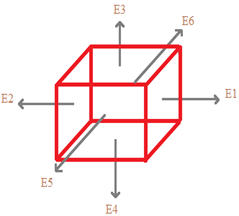
Concept explainers
Suppose you have the uniformly charged cube in FIGURE Q24.1. Can you use symmetry alone to deduce the shape of the cube 's electric field? If so, sketch and describe the field shape. If not, why not?

If symmetry alone can be used to deduce the shape of the cube’s electric field.
Explanation of Solution
Given:
The following figure of uniformly charged cube is given.

Using Gauss’s law, we can deduce electric fields, particularly those with a high degree of symmetry, simply from the shape of the charge distribution.
The pattern of the electric field through the surface is like that the shape of the charged body, if the Gaussian surface matches the symmetry of the charge dispersion inside. For a consistently charged dispersion, the shape of the Gaussian surface coincides with the shape of the electric field. So, the shape of the electric field is cubical in nature for a consistently charged cube shape that is the electric field at each point on the face of a solid shape is comparative and its direction is perpendicular to the face cube. The sketch of the electric field through each face of the consistently charged cube is appeared as follows.

Conclusion:
We can use the symmetry alone to predict the shape of the electric field, the electric field in each face of the cube will have the same magnitude and perpendicular to that face.
Want to see more full solutions like this?
Chapter 24 Solutions
Physics for Scientists and Engineers: A Strategic Approach, Vol. 1 (Chs 1-21) (4th Edition)
Additional Science Textbook Solutions
University Physics Volume 1
College Physics: A Strategic Approach (4th Edition)
Cosmic Perspective Fundamentals
The Cosmic Perspective Fundamentals (2nd Edition)
Lecture- Tutorials for Introductory Astronomy
- Two positively charged spheres are shown in Figure P24.70. Sphere 1 has twice as much charge as sphere 2. If q = 6.55 nC, d = 0.250 m, and y = 1.25 m, what is the electric field at point A?arrow_forwardA conducting rod carrying a total charge of +9.00 C is bent into a semicircle of radius R = 33.0 cm, with its center of curvature at the origin (Fig.P24.75). The charge density along the rod is given by = 0 sin , where is measured clockwise from the +x axis. What is the magnitude of the electric force on a 1.00-C charged particle placed at the origin?arrow_forwardA semicircular wire of radius R is uniformly charged with Q₁ = 4.4Q and located in a two dimensional coordinate system as shown in the figure. A point charge Q₂ = 0.4Q is placed at 0.7R on the y-axis. Determine the electric field at point o in terms of kQ/R² where is the unit vector. Take rt-3.14 and provide your answer with two decimal places. Answer: Q₁ Q₂❤ 0 R Xxarrow_forward
- Charge Q is uniformly distributed along a thin, flexible rod of length L. The rod is then bent into the semicircle shown in the figure Center 1. Find an expression for the electric field E⃗ at the center of the semicircle. Hint: A small piece of arc length Δs spans a small angle Δθ=Δs /R, where R is the radius. Express your answer in terms of the variables Q, L, unit vectors i^, j^, and appropriate constants. 2.Evaluate the field strength if L = 16 cm and Q = 36 nC . Express your answer with the appropriate units.arrow_forwardA straight wire PQ 2 m long is charged with a charge of -15 nC. A point M is in the middle of PQ at a distance of 50 cm from the wire (see figure). A ring with a charge of +20 nC and a radius of 30 cm , has its center at O. This ring, placed in such a way that MO = 1.2 m. The ring plane is perpendicular to MO.a. Find the total electric field at M!b. If at point M is placed a charge q = -5 nC, determine the magnitude and direction of the force acting on this charge q!arrow_forwardFive charged particles are equally spaced around a semicircle of radius 100 mm, with one particle at each end of the semicircle and the remaining three spaced equally between the two ends. The semicircle lies in the region x<0 of an xy plane, such that the complete circle is centered on the origin. If each particle carries a charge of 6.00 nC , what is the electric field at the origin? Where could you put a single particle carrying a charge of -5.00 nC to make the electric field magnitude zero at the origin?arrow_forward
- Chapter 22, Problem 030 SN X Incorrect. The figure shows two concentric rings, of radii Rs and R, that lie on the same plane. Point P lies on the central z axis, at distance D from the center of the rings. The smaller ring has uniformly distributed charge Qs. What is the uniformly distributed charge on the larger ring if the net electric field at P is zero? State your answer in terms of the given variables. QL = R L+D (R): 21 5+Darrow_forwardYou are helping to design a new electron microscope to investigate the structure of the HIV virus. A new device to position the electron beam consists of a charged circle of conductor. This circle is divided into two half circles separated by a thin insulator so that half of the circle can be charged positively and half can be charged negatively. The electron beam will go through the center of the circle. To complete the design your job is to calculate the electric field in the center of the circle as a function of the amount of positive charge on the half circle, the amount of negative charge on the half circle, and the radius of the circle.arrow_forwardThe electric field on the axis of a uniformly charged ring has magnitude 400 kN/C at a point 6 cm from the ring center. The magnitude 15 cm from the center is 125 kN/C; in both cases the field points away from the ring. a. Find the rings radius b. find the rings chargearrow_forward
- Consider eight charges at the corners of a cube with side length a, and its axes parallel to the Cartesian coordinate axes, and its center at the origin, (0,0,0). a. If all eight charges have a value of q, evaluate the electric field along the x-axis, and explain its behavior as x goes to infinity. b. If the four charges where z= a/2 are +q and the other four are -q , evaluate the electric field along the x axis, and explain its behavior as x goes to infinity. c. Now consider having four +q and four -q charges, with each charge having its nearest neighbor have the opposite sign. Sketch this, evaluate the electric field along the x axis, and explain its behavior as x goes to inifinity.arrow_forwardA long, thin straight wire with linear charge density λ runs down the center of a thin, hollow metal cylinder of radius R. The cylinder has a net linear charge density 2λ. Assume λ is positive. a. Find expressions for the magnitude of the electric field strength inside the cylinder, r<R. Give your answer as a multiple of λ/ε0. Express your answer in terms of some or all of the variables R, r, and the constant π. b. Find expressions for the magnitude of the electric field strength outside the cylinder, r>R. Give your answer as a multiple of λ/ε0. Express your answer in terms of some or all of the variables R, r, and the constant π.arrow_forwardThe figure below shows a plastic rod of length L with a total charge Q evenly distributed over the rod. The rod is bent into an arc with a radius R and an angle of θ = 45°. What is the electric field (magnitude and direction) at the location indicated by the black dot?arrow_forward
 Physics for Scientists and Engineers: Foundations...PhysicsISBN:9781133939146Author:Katz, Debora M.Publisher:Cengage Learning
Physics for Scientists and Engineers: Foundations...PhysicsISBN:9781133939146Author:Katz, Debora M.Publisher:Cengage Learning Principles of Physics: A Calculus-Based TextPhysicsISBN:9781133104261Author:Raymond A. Serway, John W. JewettPublisher:Cengage Learning
Principles of Physics: A Calculus-Based TextPhysicsISBN:9781133104261Author:Raymond A. Serway, John W. JewettPublisher:Cengage Learning

